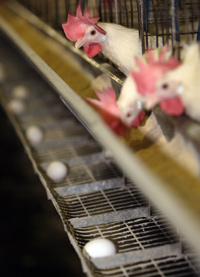



Poultry industry sees hike in production costs due to corn demand
US - Chickens eat corn. And until last year, they didn’t have to worry too much about fighting cars for their feed. Chickens gobble down their dinner of corn at the University of Georgia poultry facilities. Chickens gobble down their dinner of corn at the University of Georgia poultry facilities. |
But with 20 percent of all U.S. corn now going into making ethanol, poultry growers not only have the regular worries but have to consider how much they’re willing to pay for grain, too.
And that’s a big deal in Georgia. Broilers are the top moneymaking agriculture industry for the state, with $3.95 billion in farm value. Eggs are sixth in Georgia with a value of $422.5 million.
When corn prices go up, the state feels it.
Georgia farmers used 212 million bushels of corn in 2006, said agricultural economist John McKissick, director of the University of Georgia Center for Agribusiness and Economic Development.
“We produced about 26 million bushels,” he said. “We’re about 200 million bushels in debt. Looking at that, you can subtract $200 million from the livestock industry every time there is a dollar increase in a bushel of corn.”
Corn’s price increase has thrown the poultry industry a double whammy, increasing production costs during a time when producers are suffering from lower sale prices.
“A good thing about the poultry industry is that it’s able to adjust faster to higher feed costs,” said Mike Lacy, the poultry science department head in the UGA College of Agricultural and Environmental Sciences.
McKissick said poultry producers have adjusted by reducing their bird numbers. In 2004, broiler production was at 34 million pounds, and the average price was 74 cents per pound. In 2007, the projected broiler production is still up, but only about 2.5 million pounds more. And the average price is 67.5 cents per pound.
“Even the third largest corn crop on record couldn’t save the major feed ingredient, corn, from doubling in price by the end of 2006,” he said. Growing “competition for the 2007 corn crop from ethanol producers makes any feed cost decline unlikely.”
In 2002, ethanol plants consumed a little more than 1 billion bushels of corn, McKissick said. This year, they’ll use more than 2 billion. The federal government is pushing to use 35 billion bushels for ethanol production by 2013.
“That’s more than half of the corn [grown] currently,” he said.
But there’s a silver lining somewhere in the middle of the corn fight. Georgia has one of the major ingredients for another biofuel -- biodiesel -- in the form of chicken fat.
“We’re actually below the break-even point for biodiesel, unless we use lower-priced animal fat to produce it,” McKissick said.
But before chickens produce fat, they have to eat.
“The corn prices are a huge concern,” Lacy said. “I’m really concerned about a train wreck with corn supply, corn demand and corn prices.”
The concern grows because the United States has used up most of its corn reserves.
The bottom line on corn for poultry producers is that it actually depends on corn growers.
“We need to plant 8 million to 10 million more acres of corn in the U.S. to meet the demand,” McKissick said. “If we don’t, we haven’t seen high corn prices yet.”
ThePoultrySite News Desk








